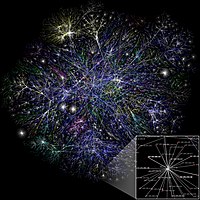
Photo from wikipedia
In this article, we develop a clique-based method for social network clustering. We introduce a new index to evaluate the quality of clustering results, and propose an efficient algorithm based… Click to show full abstract
In this article, we develop a clique-based method for social network clustering. We introduce a new index to evaluate the quality of clustering results, and propose an efficient algorithm based on recursive bipartition to maximize an objective function of the proposed index. The optimization problem is NP-hard, so we approximate the semi-optimal solution via an implicitly restarted Lanczos method. One of the advantages of our algorithm is that the proposed index of each community in the clustering result is guaranteed to be higher than some predetermined threshold, p , which is completely controlled by users. We also account for the situation that p is unknown. A statistical procedure of controlling both under-clustering and over-clustering errors simultaneously is carried out to select localized threshold for each subnetwork, such that the community detection accuracy is optimized. Accordingly, we propose a localized clustering algorithm based on binary tree structure. Finally, we exploit the stochastic blockmodels to conduct simulation studies and demonstrate the accuracy and efficiency of our algorithms, both numerically and graphically.
Journal Title: Journal of Classification
Year Published: 2020
Link to full text (if available)
Share on Social Media: Sign Up to like & get
recommendations!